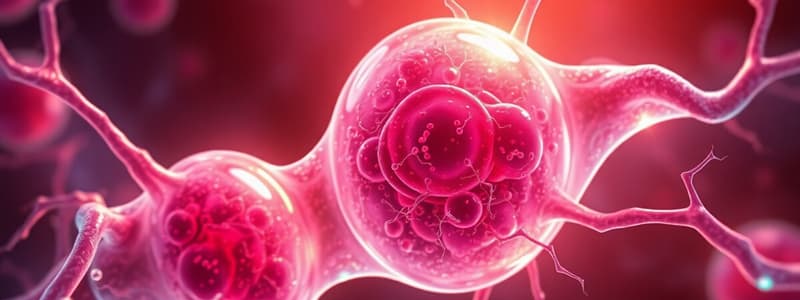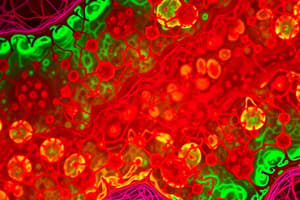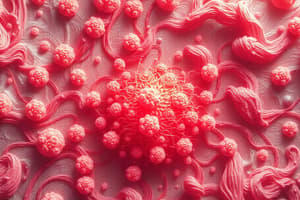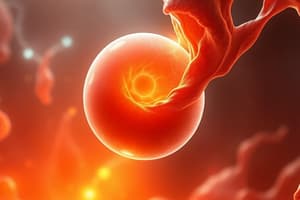Podcast
Questions and Answers
Which three primary germ layers are formed during gastrulation?
Which three primary germ layers are formed during gastrulation?
- Ectoderm, Mesoderm, Endoderm (correct)
- Ectoderm, Mesoderm, Stroma
- Mesoderm, Endoderm, Myoepithelium
- Ectoderm, Parenchyma, Endoderm
What process involves the deformation of an epithelial sheet to form the primitive gut?
What process involves the deformation of an epithelial sheet to form the primitive gut?
- Embryogenesis
- Gastrulation (correct)
- Cleavage
- Organogenesis
Which of the following is NOT an extrinsic signal that induces epithelial-mesenchymal transition (EMT)?
Which of the following is NOT an extrinsic signal that induces epithelial-mesenchymal transition (EMT)?
- Wnt
- TGF-β
- Insulin (correct)
- EGF
Which intracellular pathway is involved in the signaling of EMT?
Which intracellular pathway is involved in the signaling of EMT?
What role do the Snail and Slug proteins play in cellular processes?
What role do the Snail and Slug proteins play in cellular processes?
What cellular event occurs when E-cadherin undergoes cleavage?
What cellular event occurs when E-cadherin undergoes cleavage?
Which germ layer is primarily involved in heart development during gastrulation?
Which germ layer is primarily involved in heart development during gastrulation?
What is the main role of the basal lamina in the EMT process?
What is the main role of the basal lamina in the EMT process?
What is the primary reason most cancer-related deaths occur?
What is the primary reason most cancer-related deaths occur?
Which of the following statements about tumors and metastasis is true?
Which of the following statements about tumors and metastasis is true?
What does the invasion-metastasis cascade involve?
What does the invasion-metastasis cascade involve?
Which type of tumors is least likely to metastasize?
Which type of tumors is least likely to metastasize?
What role does organ fibrosis play in cancer development?
What role does organ fibrosis play in cancer development?
Which statement accurately describes micrometastases?
Which statement accurately describes micrometastases?
Why is understanding metastasis crucial for extending patient survival?
Why is understanding metastasis crucial for extending patient survival?
What factor is most likely to predict metastasis?
What factor is most likely to predict metastasis?
What is the primary role of epithelial-mesenchymal transition (EMT) in cellular processes?
What is the primary role of epithelial-mesenchymal transition (EMT) in cellular processes?
Which of the following proteins is known to increase in abundance during the epithelial-mesenchymal transition?
Which of the following proteins is known to increase in abundance during the epithelial-mesenchymal transition?
Which characteristic is NOT typical of mesenchymal cells?
Which characteristic is NOT typical of mesenchymal cells?
What initiates the process of epithelial-mesenchymal transition?
What initiates the process of epithelial-mesenchymal transition?
During which developmental process does epithelial-mesenchymal transition play a crucial role?
During which developmental process does epithelial-mesenchymal transition play a crucial role?
Which feature distinguishes epithelial cells from mesenchymal cells?
Which feature distinguishes epithelial cells from mesenchymal cells?
Which transcription factor is associated with promoting epithelial-mesenchymal transition?
Which transcription factor is associated with promoting epithelial-mesenchymal transition?
What is a common outcome of altered epithelial-mesenchymal transition in cancer?
What is a common outcome of altered epithelial-mesenchymal transition in cancer?
In terms of function, what does the basolateral surface of epithelial cells primarily engage in?
In terms of function, what does the basolateral surface of epithelial cells primarily engage in?
What type of cells can arise from both epithelial and mesenchymal origins?
What type of cells can arise from both epithelial and mesenchymal origins?
Flashcards
What is metastasis?
What is metastasis?
A process where cancer cells spread from the primary tumor to distant sites in the body, leading to the formation of new tumors.
Cancer metastasis cascade
Cancer metastasis cascade
The process of cancer cells migrating from the primary tumor to distant sites in the body.
Epithelial to Mesenchymal Transition (EMT)
Epithelial to Mesenchymal Transition (EMT)
A type of cell transition where epithelial cells lose their characteristics and gain mesenchymal properties, becoming more migratory and invasive.
Metastasis genes
Metastasis genes
Signup and view all the flashcards
Tumor invasion
Tumor invasion
Signup and view all the flashcards
Metastasis
Metastasis
Signup and view all the flashcards
Tissue tropism
Tissue tropism
Signup and view all the flashcards
Micrometastases
Micrometastases
Signup and view all the flashcards
Gastrulation
Gastrulation
Signup and view all the flashcards
Epithelial-Mesenchymal Transition (EMT)
Epithelial-Mesenchymal Transition (EMT)
Signup and view all the flashcards
Snail Family of Transcriptional Repressors
Snail Family of Transcriptional Repressors
Signup and view all the flashcards
Extrinsic Signals Inducing EMT
Extrinsic Signals Inducing EMT
Signup and view all the flashcards
Intracellular Pathways in EMT
Intracellular Pathways in EMT
Signup and view all the flashcards
Transcriptional Regulation in EMT
Transcriptional Regulation in EMT
Signup and view all the flashcards
Stromal Cell Control of EMT
Stromal Cell Control of EMT
Signup and view all the flashcards
Cell Migration
Cell Migration
Signup and view all the flashcards
Epithelial Cells
Epithelial Cells
Signup and view all the flashcards
Mesenchymal Cells
Mesenchymal Cells
Signup and view all the flashcards
E-cadherin
E-cadherin
Signup and view all the flashcards
N-cadherin
N-cadherin
Signup and view all the flashcards
Vimentin
Vimentin
Signup and view all the flashcards
Neural Crest Delamination
Neural Crest Delamination
Signup and view all the flashcards
Wound Healing
Wound Healing
Signup and view all the flashcards
Tissue Fibrosis
Tissue Fibrosis
Signup and view all the flashcards
Study Notes
Epithelial-Mesenchymal Transition (EMT)
- EMT is a series of orchestrated events altering cell-cell and cell-extracellular matrix (ECM) interactions.
- Epithelial cells are released from surrounding tissue.
- Cytoskeleton is reorganized for 3D movement in the ECM.
- A new transcriptional program maintains the mesenchymal phenotype.
Cell Types
- Epithelial cells form sheets, typically one cell thick, with cells tightly joined.
- Mesenchymal cells lack a regimented structure and have few intracellular adhesions, allowing for mobility.
- All animals begin as epithelial cells, capable of forming all three germ layers (ectoderm, mesoderm, and endoderm).
Characteristics of Epithelial Cells
- Typically a single cell layer thick.
- Cells abut and join each other.
- Regularly spaced junctions and adhesions between cells.
- Tight adhesion inhibiting movement away from the monolayer.
- Enclose a 3D space within the monolayer, providing structural definition and rigidity.
- Polarized with a negative charge inside the cell membrane compared to the outside.
- Apical and basal surfaces often differ structurally and functionally.
- Adhere to different substrates (ECM).
Characteristics of Mesenchymal Cells
- Lack regimented structure.
- Few tight intracellular adhesions.
- Weak adhesions allowing for mobility.
- Form irregular structures, not uniform in composition or density.
- Extended and elongated shape.
EMT Markers
- Increased abundance: N-cadherin, Vimentin, Fibronectin, Snail1 (Snail), Snail2 (Slug), Twist, Goosecoid, FOXC2, Sox10, MMP-2, MMP-3, MMP9, Integrin vβ6.
- Decreased abundance: E-cadherin, Desmoplakin, Cytokeratin, Occludin.
- Increased activity: ILK, GSK-3B, Rho.
- Accumulate in the nucleus: β-catenin, Smad-2/3, NF-κB, Snail1 (Snail), Snail2 (Slug), Twist.
Biochemical Changes Accompanying EMT
- Expressing Twist transcription factor in MDCK cells induces fibronectin and vimentin.
- Changes include decreases in epithelial markers and increases in mesenchymal markers.
EMT in Development and the Adult
- EMT plays a role in gastrulation and neural crest delamination during development.
- In adults, EMT is involved in wound healing, tissue fibrosis, and cancer metastasis.
Animal Development - I
- Early cleavage forms a ball of cells (blastocyst) with a hollow space (blastocoel).
- The initial structure is an epithelium folded into a ball.
- The second phase involves the formation of a triploblastic embryo.
- Three primary germ layers: ectoderm, mesoderm, and endoderm.
- The process is called gastrulation.
Gastrulation
- Two processes are involved in gastrulation:
- The epithelial sheet deforms as a unit.
- A small number of cells at the base or vegetal plate lose contact with neighbors, detach from the basal lamina, and crawl into the blastocoel.
EMT in Tissues
- Epithelium I induces an EMT process in Epithelium II through secreted inducers (intermediary signal molecules).
- The mesenchymal population is recruited and differentiates based on molecular information from the inducing tissue.
EMT and Cancer
- EMT allows benign tumors to infiltrate surrounding tissue and metastasize to distant sites.
- EMT stages are observed in pathological staging of tumors.
What is Metastasis?
- Tumors take years to detect, particularly if growing in extensible space.
- Metastasis occurs when the tumor compromises organ function, prompting symptoms.
- Primary tumors are less lethal than metastasis, which occurs in distant sites.
- Understanding metastasis could greatly extend survival.
What is Metastasis (Further Discussion)?
- Primary tumors rarely cause death, metastasis does in 90% of cases.
- Primary tumor size often predicts metastasis risk.
- Some tumors don't metastasize (skin squamous cell carcinomas, brain glioblastomas), others do frequently (melanoma).
- Some types of tumors exhibit a propensity for specific tissues (breast, prostate to bone) at metastasis.
- Micrometastases at diagnosis correlate with poorer outcomes in breast and colon cancers.
- Organ fibrosis increases risk for aggressive cancer development, such as hepatic cirrhosis and lung fibrosis.
How Do Tumors Spread?
- The process, called the invasion-metastasis cascade, has 6 steps:
- Primary tumor formation.
- Localized invasion.
- Intravasation.
- Transport through circulation.
- Arrest in microvessels of various organs.
- Extravasation (exit from microvessel).
- Formation of micrometastasis.
- Colonization and formation of macrometastasis.
- The probability of a single cancer cell completing the metastasis is low.
Are There Metastasis Genes?
- Studies show that various genes are involved with metastasis.
- Some genes are downregulated, others upregulated, and some show expression patterns characteristic of metastasis.
- Genes associated with metastasis correlate with survival prognosis for certain cancers.
EMT in Tumor Progression
- EMT is critical in tumor progression, moving from localized to invasive carcinoma (and eventually to micrometastasis).
Cancer Metastasis Process
- Involves multiple sequential steps following tumor growth and progression.
- Stages can be described as cancer in situ, invasive carcinoma, intravasation, transport in circulation, extravasation, colonization, and micrometastasis formation.
Cancer Metastasis (Molecular Mechanisms)
- EMT involves the loss of adherens junctions (like E-cadherin) and cytoskeletal changes.
- β-catenin's translocation into the nucleus occurs due to EMT, which plays a role in metastasis.
Cancer Metastasis (Other Considerations)
- Stages include detachment of cells, basement membrane degradation, invasion, and intravasation; followed by circulation, extravasation, proliferation, and microenvironmental activation, culminating in the final formation of growing metastases.
Studying That Suits You
Use AI to generate personalized quizzes and flashcards to suit your learning preferences.
Related Documents
Description
This quiz explores the fundamental concepts of Epithelial-Mesenchymal Transition (EMT) and the differences between epithelial and mesenchymal cells. Understand the roles, characteristics, and transformations that cells undergo during EMT. Test your knowledge on the structure and function of these essential cell types.



